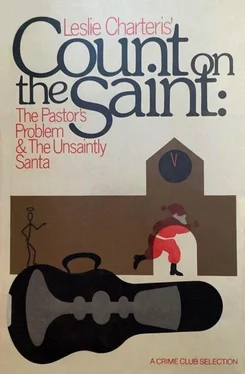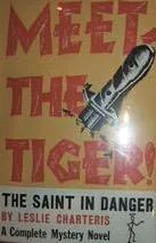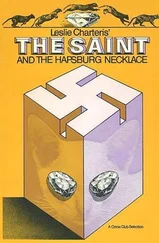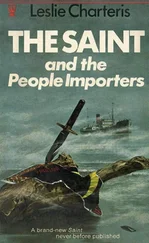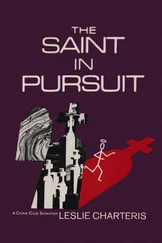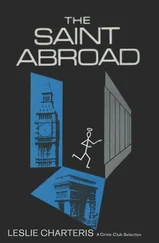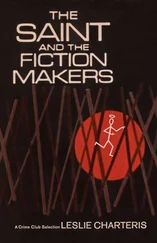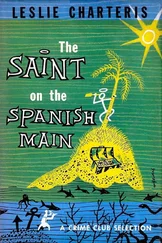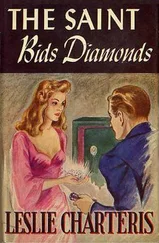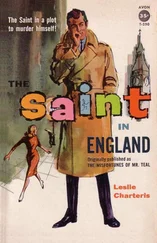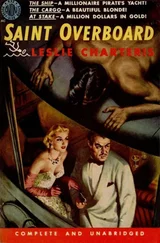The word “sharpshooter” had jolted in his brain as his lips framed the syllables. For the first time since the murder of Colonel Harker he smiled.
Darslow seemed to sense the change that had come over him and glanced towards him expectantly, still without quite meeting his eyes. But if he hoped for some startling revelation, he was to be disappointed.
“I’ll see you later,” was all Simon said as he turned to leave.
“May I ask where you are going, if not to the police?”
The saintly smile broadened.
“To see a man about a lion,” he replied helpfully.
And then he was gone.
Simon Templar had a way of disappearing like that when he wished to avoid explaining his actions. His exit line had been flip, but Chantek would have understood it. He felt certain that the key to everything that had happened was hidden somewhere within the college or in the brain of one of its staff. And the same intuition warned him that the events which had embroiled him had not yet completed their mysterious purpose, so the less the elders of St. Enoch’s knew of his plans the more he might discover about theirs.
The porter at the entrance told him where to find a door bearing the name of Denzil Rosco. The Saint knocked, waited for a summons to enter, and, receiving none, went in anyway.
Rosco’s study was a direct contrast to the room he had just left. Darslow’s was tidy to the point of primness, whereas Rosco’s was more of an organised shambles. It was the difference between a solicitor’s office and a student’s den. The law tutor’s shelves had bowed beneath the weight of obese tomes bound in leather. The zoologist’s bookcases were packed with large glossy-covered works and well-thumbed paperbacks, which spilled out into small stacks on the floor, on chairs, and across a table that separated two tall filing cabinets on the opposite side of the room; and what little space they left was littered with bulging files, magazines, and notebooks.
On one side of the door was a large map of the world dotted with different coloured flags so that it resembled a global golf course, but there was no clue to what they indicated. Taking up most of the space on the other side was a display cabinet mounted on a low three-drawer chest, which contained the trophies Chantek had mentioned.
They made an impressive collection, illustrating in silver and bronze their owner’s skill with rifle, shotgun, and, most interestingly, pistol. Lined above the chest were framed photographs of Rosco in various exotic landscapes.
His desk backed onto a high bay window that looked across the east quadrangle directly in line with the spot where Sir Basil Lazentree had been murdered. The Saint sat at the desk and routinely tried the drawers. All were unlocked, but each contained only the miscellaneous stationery that could be expected.
The display cabinet faced the desk, and his attention returned to the array of cups and salvers. Rosco’s marksmanship was, after all, the prime object of his interest.
He rose and crossed the room and opened each drawer in turn. The contents of the first two drawers were unexciting. A telescopic sight in its case, a ramrod, rags and oil for cleaning a rifle, a shoulder sling for carrying same, a cartridge belt minus cartridges, some small paper targets whose groupings of holes testified to the prowess of the man who made them, a canvas pouch of indeterminable use, a pair of binoculars, and some back copies of Shooting Monthly. The bottom drawer was the only one that was locked.
The mechanism was a simple single-bar mortice. It took the Saint precisely one minute to open it, thirty seconds of which were taken up with the bending of a large paper clip into the required angles.
The drawer contained only two items. One was a half-empty box of .22 cartridges. The other was a tooled black leather case about the same size as a canteen of cutlery with the initials D.R. worked into a gold-leaf monogram on the lid.
Simon flicked up the gilt clasp. Inside, the case was lined with purple felt and fitted with small square and rectangular mouldings strategically placed to hold the contents secure. Only the pistol they were designed to protect was missing.
As the Saint and every member of the newspaper-reading populace was aware, it was also a .22 which had terminated the earthly existence of Mr. Stanton Wakeforth.
At which point the average sleuth could have been pardoned for shouting “Eureka” and beating the world sprint record to take his discovery to the nearest police station. Simon Templar, however, considered his find with the cool detachment of a professional.
One .22-calibre bullet looks the same as any other .22-calibre bullet, and only tests carried out by a ballistics expert can determine whether they have both been fired from the same gun. The Saint had no doubt that within a short time the police would have made the comparisons and decided whether the same weapon was used to murder both Stanton Wakeforth and Colonel Harker. Therefore the only new ray of light he could cast on the investigations was to announce that Professor Rosco owned a .22 target pistol, but as British law requires all firearms to be licensed the police would very soon know that too — even if they did not know it already. And there must have been many other .22 guns in Cambridge. Which meant that to tell Superintendent Nutkin what he had found would only result in having to explain what he was doing near Bucksberry that morning, as well as burglarising Rosco’s study. If he had found the pistol things might have been different, as it would then have been possible to discover whether it was used to fire the shots. But the pistol was not there, and neither was Professor Rosco.
He had still not found a connecting link between the three murders, and without that he had no way of guessing whether and where the murderer might strike again.
What little he had discovered had been largely the result of waiting on events and backing an instinct sharpened by many years of adventuring. He decided to keep to the same route.
He wiped off the box of cartridges and the pistol case, replaced them in the drawer, and relocked it. He doubted that the room had any more secrets to reveal, and with a final lingering look around and a rapid polishing of other things he had touched to remove his own fingerprints, he left the study.
He was retracing his steps towards the college gates when he turned a corner and almost collided with the hurrying person of Godfrey Nyall.
The bursar stepped back abruptly with a surprised expression. He looked as if he had dressed hastily that morning. The scuffed shoes, the sag in the knot of his tie, and his rumpled clothes were in contrast to the neatly attired man who had appeared at the hotel the previous morning and later dispensed sherry in the common room.
“Mr. Templar!” he exclaimed rather breathlessly. “I didn’t know you were in the college.”
Simon had been thinking of seeking out the bursar before leaving St. Enoch’s.
“Actually I was looking for you,” he lied smoothly. “But I couldn’t find your office.”
“It’s near the main entrance,” said Nyall. “You must have passed it when you came in.”
The Saint smiled disarmingly.
“How silly of me. Can you spare a few minutes?”
The bursar hesitated for only a moment and then nodded.
“Of course. I just have to collect something from the common room. Perhaps you would wait for me in my office.”
“Sure,” said the Saint, and strolled away, conscious as he did so that the bursar had not moved and was watching him go.
As Nyall had said, it would have been hard to use the main entrance and miss his office. There were in fact two offices, an outer one with a desk for a secretary and beyond that the bursar’s own sanctum. The typewriter was hooded and the desk top beside it bare, suggesting that the secretary, like the students, was on holiday. Nyall’s office was spacious and imposing in the severe Victorian manner of large mahogany furniture and dark-coloured carpet. Those walls not hidden behind lattice-fronted bookcases were adorned with portraits in carved wooden frames and a few landscape prints in gilt surrounds.
Читать дальше
